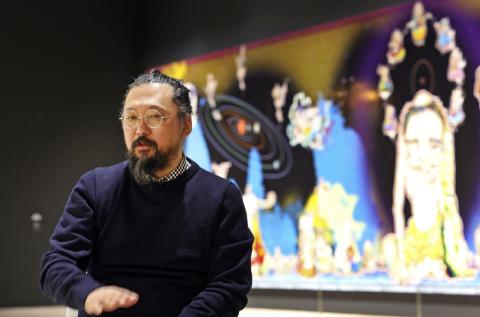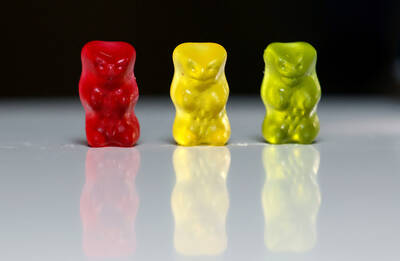In the gentrified kitsch landscape Takashi Murakami depicts, 500 grotesque priests parade along dazzlingly colorful giant panels.
The artist’s zany ukiyoe-turned-manga world takes a spiritual, but uncompromising pop art, turn in addressing the 2011 tsunami and nuclear disaster. But the old men in The 500 Arhats installation at Mori Art Museum in Tokyo also show reality in the world’s fastest aging society.
“This is a self-portrait of Japan,” Murakami told the AP this week.

Photo: AP/ Eugene Hoshiko
Dubbed the “Andy Warhol of Japan,” Murakami is showing his first major retrospective in Japan in 14 years.
After the Fukushima disaster, Murakami felt a need to express the sense of desperation and catastrophe, and to try to contribute to healing.
The motif of Buddha’s disciples is common in traditional Japanese art. But Murakami’s arhat figures leer back at the world, some with toothless grins, as though stuck in half-crazed greed rather than seeking enlightenment.

Photo: AP/ Eugene Hoshiko
The giant panels, 100 meters long in total, are covered with raging fire and glitter-speckled cosmic skies. Dragons strike contorted poses, next to elephants and a white tiger. And there are lots and lots of aging men, of various sizes and shapes, with pot bellies, bald heads and wrinkled foreheads.
“In another era, I’d be a grandpa,” said Murakami, 53. “My art has always been about exaggerating the weird characteristics of Japanese society.”
Murakami uses dozens of assistants to create large-scale artworks — often with repetitive themes, be it laughing flowers, psychedelic skulls or deformed old men. They work in his version of Warhol’s Factory, though he stresses gorgeous celebrities don’t frequent the studio that’s run more like a humble Japanese manufacturing company.
His signature icon is the Mickey Mouse-like Mr Dob. Murakami has also created huge erotic sculptures of animation-inspired female figures that have fetched enormous auction prices. In recent years, he has become a filmmaker.
FROM RAGS TO US$4,000 TOTE BAGS
Murakami has won both praise and criticism for his unabashed commercialism, starting his own brand Kaikai Kiki Co, which sells not just the usual postcards and art books, but also mugs, cushions, cellphone cases and T-shirts emblazoned with his designs, as well as figures and dolls.
In his typically defiance, Murakami recommends exhibit viewers keep their serious spirituality to about 30 percent of their energy, and revel in tourism, splurging and fun for the rest.
The official shop that’s part of the exhibit is taking orders for a US$4,000 tote bag with Murakami’s skull design, complete with a certificate.
Murakami designed Louis Vuitton bags about a decade ago that sold for similarly exorbitant prices, although Murakami acknowledged at the time he had never owned such an expensive bag in his life.
At the museum coffee shop, where walls are splashed with Murakami flowers and his balloon figures hang from the ceiling, visitors enjoy a selection of cakes and omelets in flower shapes.
At the entrance stands a striking life-size likeness of Murakami, with rolling eyes and moving lips — except the top face is peeling off to reveal yet another face — an eerie reminder that art, like life and truth, can be illusory.
But Murakami insists neither time nor fame has changed him as an artist.
He grew up poor, he said. Japan was in a perpetual identity crisis, having just been defeated in World War II.
A graduate of the prestigious Tokyo University of the Arts, he went on to invent his approach and named it Superflat — a take on that unique sense of perspective and emphasis of clear outlines that woodblock printers like Hokusai invented.
It all comes back, Murakami said, to the question he has addressed all his life: What is Japan?
“Superflat has not changed at all,” he said.

Desperate dads meet in car parks to exchange packets; exhausted parents slip it into their kids’ drinks; families wait months for prescriptions buy it “off label.” But is it worth the risk? “The first time I gave him a gummy, I thought, ‘Oh my God, have I killed him?’ He just passed out in front of the TV. That never happens.” Jen remembers giving her son, David, six, melatonin to help him sleep. She got them from a friend, a pediatrician who gave them to her own child. “It was sort of hilarious. She had half a tub of gummies,

June 23 to June 29 After capturing the walled city of Hsinchu on June 22, 1895, the Japanese hoped to quickly push south and seize control of Taiwan’s entire west coast — but their advance was stalled for more than a month. Not only did local Hakka fighters continue to cause them headaches, resistance forces even attempted to retake the city three times. “We had planned to occupy Anping (Tainan) and Takao (Kaohsiung) as soon as possible, but ever since we took Hsinchu, nearby bandits proclaiming to be ‘righteous people’ (義民) have been destroying train tracks and electrical cables, and gathering in villages

The wide-screen spectacle of Formula One gets a gleaming, rip-roaring workout in Joseph Kosinski’s F1, a fine-tuned machine of a movie that, in its most riveting racing scenes, approaches a kind of high-speed splendor. Kosinski, who last endeavored to put moviegoers in the seat of a fighter jet in Top Gun: Maverick, has moved to the open cockpits of Formula One with much the same affection, if not outright need, for speed. A lot of the same team is back. Jerry Bruckheimer produces. Ehren Kruger, a co-writer on Maverick, takes sole credit here. Hans Zimmer, a co-composer previously, supplies the thumping

Swooping low over the banks of a Nile River tributary, an aid flight run by retired American military officers released a stream of food-stuffed sacks over a town emptied by fighting in South Sudan, a country wracked by conflict. Last week’s air drop was the latest in a controversial development — private contracting firms led by former US intelligence officers and military veterans delivering aid to some of the world’s deadliest conflict zones, in operations organized with governments that are combatants in the conflicts. The moves are roiling the global aid community, which warns of a more militarized, politicized and profit-seeking trend